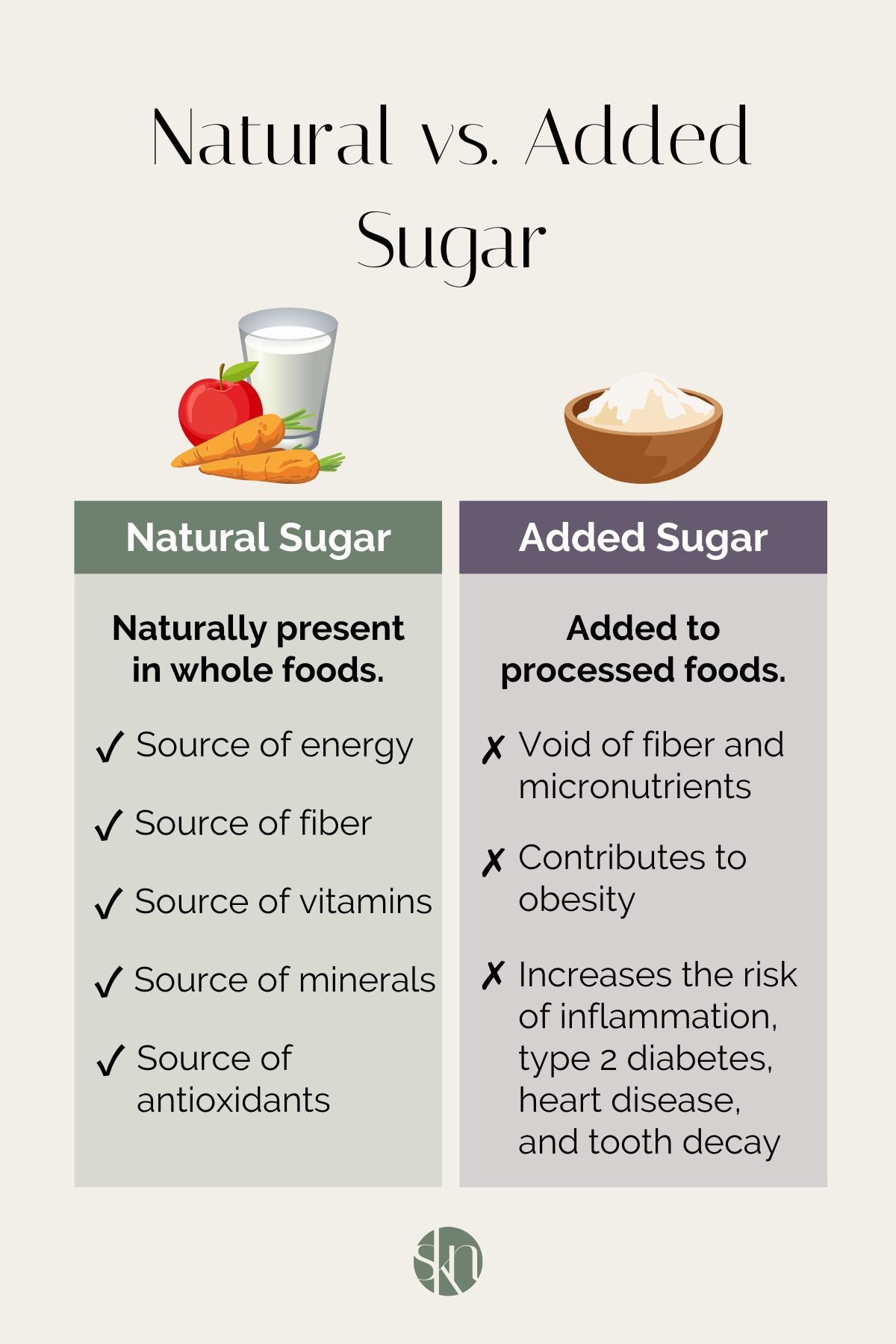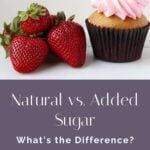While most people know that too much sugar can be problematic for health, not all sugar is created equal. Here is a breakdown of natural sugar vs. added sugar, the pros and cons of each, and some tips on how to limit your added sugar intake.

Table of contents
What’s the difference between natural sugar and added sugar?
Natural sugars are the sugars naturally occurring in unprocessed foods. Sugar is a form of carbohydrate and includes monosaccharides (glucose, fructose, and galactose) and disaccharides (sucrose, maltose, and lactose) (1). Examples of foods with natural sugars include:
- Fruits
- Vegetables
- Milk, and dairy products
Added sugars are sugars that are added during the production of processed foods, such as sucrose or corn syrup, packaged as sweeteners, such as table sugar or honey, or sugars from concentrated fruit and vegetable juices (2). Examples of added sugars include:
- White sugar
- Brown sugar
- Cane sugar
- Coconut sugar
- High fructose corn syrup
- Honey
- Maple syrup
- Agave nectar
In addition to natural and added sugar, the term “refined sugars” is commonly used. Refined sugars are sugars obtained by extracting natural sugars from foods such as sugar cane, sugar beets, or corn. They are highly processed and used to sweeten foods and beverages as added sugar.
Refined sugars are always classified as added sugars; however, added sugars are not always refined. For example, raw honey is a natural sugar and can be added to food during the production process, however, raw honey itself is not refined. Although raw honey can be refined, therefore, not all honey is 100% natural.

Nutrition of Natural vs. Added Sugars
Naturally occurring sugars are naturally found in the presence of other macronutrients and micronutrients, while added sugars, particularly refined sugars, are generally void of nutrients. Here is a nutrient comparison of foods with different types of sugar (3, 4, 5, 6):
| Nutrition | 1 banana | 1 cup carrots | 1 cup milk | 2 tsp sugar |
| Calories | 94 calories | 53 calories | 122 calories | 32 calories |
| Protein | 0.8 grams | 1.2 grams | 8.2 grams | 0 grams |
| Fat | 0.2 grams | 0.3 grams | 4.7 grams | 0 grams |
| Carbohydrates | 22.1 grams | 12.3 grams | 12.0 grams | 8.0 grams |
| Fiber | 1.9 grams | 3.6 grams | 0 grams | 0 grams |
| Sugar | 17.4 grams | 6.1 grams | 12.0 grams | 8.0 grams |
| Vitamin A | 1 mcg | 1,068 mcg | 203 mcg | 0 grams |
| Vitamin B6 | 0.3 mg | 0.2 mg | 0.2 mcg | 0 grams |
| Vitamin C | 10.7 mg | 7.6 mg | 0 grams | 0 grams |
| Calcium | 5.5 mg | 42.0 mg | 309 mg | 0 grams |
| Potassium | 394 mg | 410 mg | 390 mg | 0 grams |
| Magnesium | 29.7 mg | 15.4 mg | 29.4 mg | 0 grams |
Health Benefits of Natural Sugars
There are many health benefits of consuming natural sugars from whole foods such as fruits, vegetables, and dairy. Natural sugars are a:
- Source of energy
- Source of fiber
- Source of vitamins and minerals
- Source of antioxidants
Given that natural sugars are present in whole foods and are good sources of fiber and micronutrients, they can aid in balancing blood sugar and improve satiety and weight management.
Problem with Added Sugars
While added sugars are safe to consume in moderate amounts as part of a balanced diet, excessive consumption of added sugars can contribute to various health problems. The concerns of added sugar include (7, 8, 9, 10, 11):
- Void of fiber
- Void of vitamins and minerals
- Void of antioxidants
- Contribute to weight gain and obesity
- Increase chronic inflammation
- Increase the risk of type 2 diabetes
- Increase the risk of heart disease
- Increase the risk of tooth decay
How much added sugar can you eat in a day?
The Dietary Guidelines for Americans recommends that added sugars should make up no more than 10% of total calorie intake, and ideally no more than 5% (12). For an average 2,000-calorie-a-day diet, that is roughly 200 calories, 12 teaspoons, or 48 grams of added sugars from both food and beverages.
This would include everything from fruit juices with added sugar to granola bars and sweetened coffee, for example (13, 14, 15, 16, 17, 18):
- 1 can of soda contains 39 grams of added sugars
- 1 cup of fruit punch contains 22 grams of added sugars
- 1 granola bar contains 12 grams of added sugars
- 3/4 cup vanilla yogurt contains 11 grams of added sugars
- 1 cup of breakfast cereal contains 12 grams of added sugars
- 1 tall caramel macchiato contains 23 grams of added sugars
Unfortunately, the average American consumes over 500 calories of sugar per day, which is 25% of the recommended daily calorie intake for women and 20% of the recommended daily calorie intake for men (19). While it’s not possible to become addicted to sugar in the same way as drugs or alcohol, it is possible to develop a strong dependence on sugar, leading to cravings and overconsumption, which can lead to serious health problems.
How to Identify Added Sugars
The best way to identify added sugars is to read food labels on food products and beverages. The nutrition facts label lists the amount of “Total Sugars” and “Added Sugars” the product contains (2). The “Total Sugars” includes all sugars present, both natural and added, while the “Added Sugars” distinguishes those that were added during the processing of the product.
The ingredients list will also display all ingredients and added sugars, listed in descending order by weight, in food and beverages. Words for added sugar include those ending in “ose”, such as fructose, sucrose, maltose, and dextrose; words with sugar in the name, such as brown sugar, cane sugar, and coconut sugar; syrups such as corn syrup, high-fructose corn syrup, and rice syrup; and other words such as agave nectar and fruit juice concentrates.

The Bottom Line
Natural sugars are found in nutrient-dense whole foods, while added sugars are sugars added to processed foods. While many foods and beverages contain sugar, including apples, sweet potatoes, and sugar-sweetened beverages, added sugars are void of nutritional value and contribute to many serious health concerns. To limit intake of added sugars, read the nutrition facts label and ingredients list on food labels.





Hi Stephanie,
I noticed in one of your gluten free recipes that you included rye. That is not a gluten free grain even though it is not wheat. You might consider removing that recipe from the gluten free list of recipes.
Thank you for the article on sugars.
I am not a user of anything but my desktop computer for nutrition info and communication.
John
Oh, where did you see that, John? If that’s the case, it’s most certainly an error, but I’m not sure what recipe your referring to?
Recently, I have become more conscious of added sugars in my diet and I found this article to be very helpful. I do think there is possibly one mistake in the table comparing the nutrients of various foods. In the last column, 2 teaspoons sugar, shouldn’t the sugars and carbohydrates be 8 g?
Regardless, I have referred back to this article a number of times in the last week as I am reading labels more carefully. Thank you!
Hi Janine,
Yes, it appears there was an error in the chart, it has been amended.
Thanks for your insight!